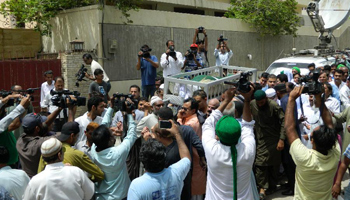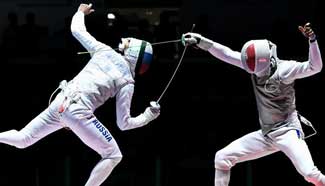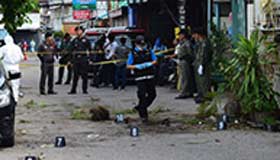By Xinhua writers Yang Chunxue and Yu Fei
BEIJING, Aug. 13 (Xinhua) -- Amid the intense preparations for the launch of China's first quantum communication satellite, scientists hope it can help unravel one of the strangest phenomena in quantum physics -- quantum entanglement.
By beaming individual entangled photons between space and ground stations, the satellite should be able to test whether the quantum's entanglement property extends over the record-breaking distance.
"We have the technology to produce pairs of entangled photons on the satellite," said Pan Jianwei, academician of Chinese Academy of Science and chief scientist of Chinese quantum communication satellite project.
One photon of an entangled pair will be beamed to a station in Delingha, northwest China's Qinghai Province, and the other to a station in Lijiang, southwest China's Yunnan Province, or in Urumqi, capital of Xinjiang Uygur Autonomous Region in northwest China. The distance between the two ground stations is about 1,200 kilometers.
"SPOOKY ACTION"
Quantum physics is the study of the basic building blocks of the world at a scale smaller than atoms. These tiny particles behave in a way that could overturn assumptions of how the world works.
One of the strange properties of quantum physics is that a tiny particle acts as if it's simultaneously in two locations -- a phenomenon known as "superposition." The noted interpretation is the thought experiment of Schrodinger's cat -- a scenario that presents a cat that may be simultaneously both alive and dead.
If that doesn't sound strange enough, quantum physics has another phenomenon that so confounded Albert Einstein that he described as "spooky action at a distance" in 1948.
Scientists found that when two entangled particles are separated, one particle can somehow affect the action of the far-off twin at a speed faster than light.
Scientists liken it to two pieces of paper that are distant from each other; if you write on one, the other immediately shows your message.
In the quantum entanglement theory, this bizarre connection can happen even when the two particles are separated by the galaxy.
SKY IS NOT THE LIMIT
The mystery of quantum entanglement has been puzzling scientists since it was detected.
"If you think you understand quantum mechanics, you don't understand quantum mechanics," said Richard Feynman, the late Nobel physics laureate.
Nobel Prize winner Murray Gell-Mann has described quantum mechanics as "that mysterious, confusing discipline, which none of us really understands, but which we know how to use."
Pan and other scientists desperately want to understand the mystery.
To his delight, the quantum communication satellite project he's leading might soon reveal the secret.
If you want to explore new physics, you must push the limits, Pan said in an interview with scientific journal Nature in January.
Pan believes that quantum entanglement exists over any distance in principle, but he wants to see if there's some physical limit with the help of the satellite.
"People ask if there's some sort of boundary between the classical world and the quantum world: we hope to build some sort of macroscopic system in which we can show that quantum phenomena can still exist," he said.
Pan also revealed that they also want to see if it's possible to distribute entanglement between the Earth and the Moon in future.










